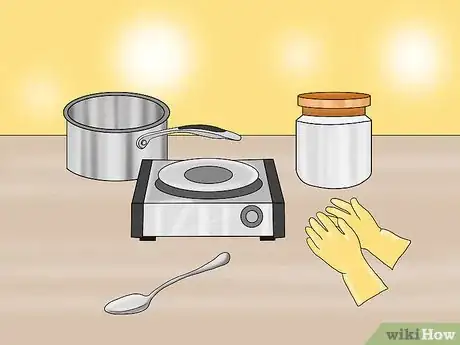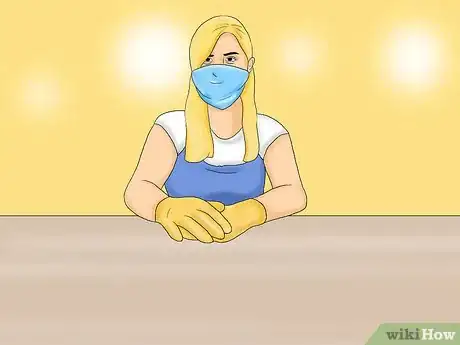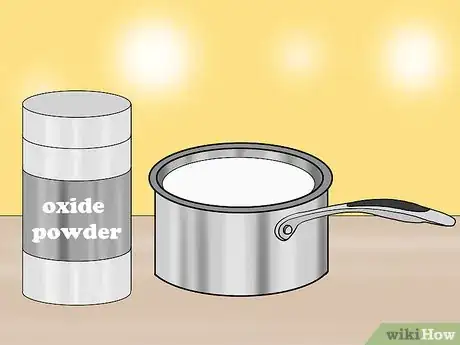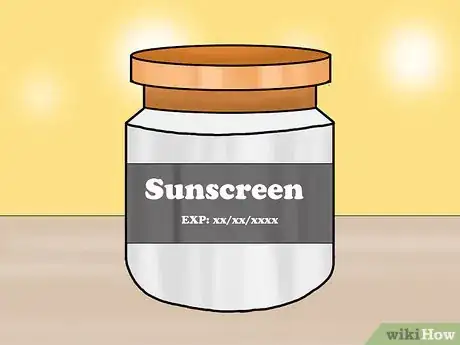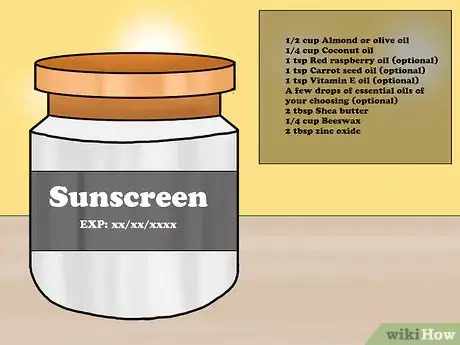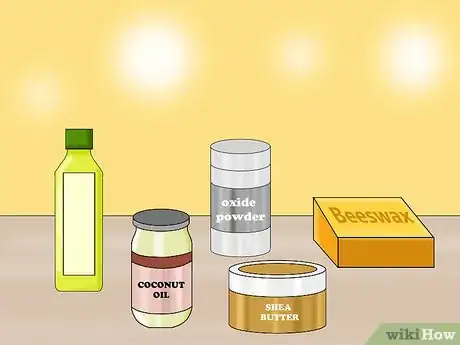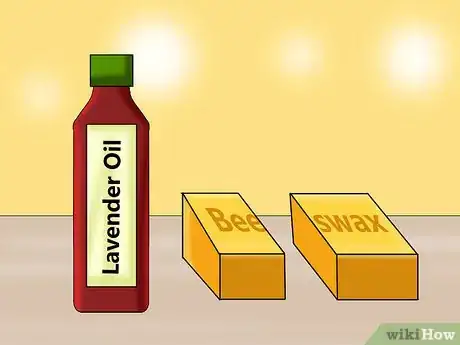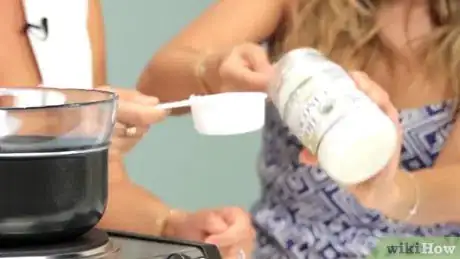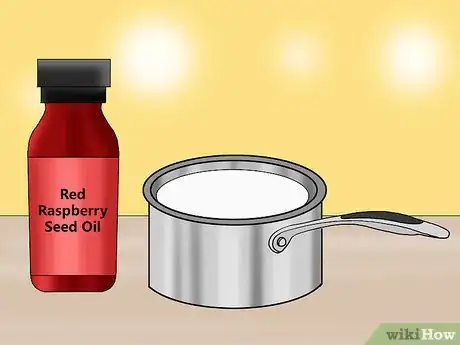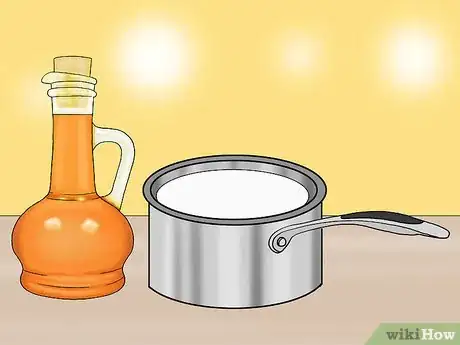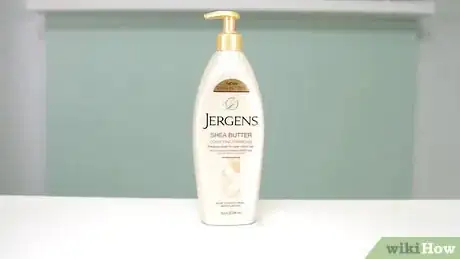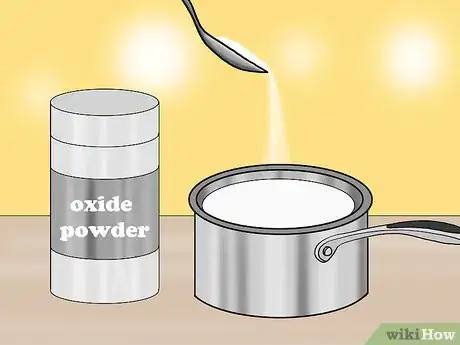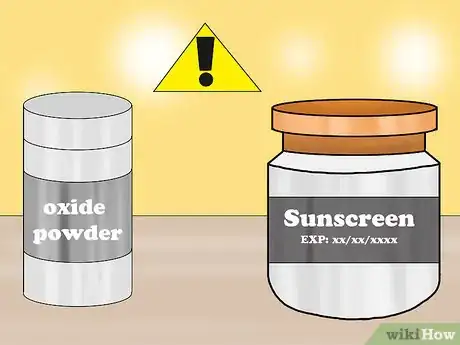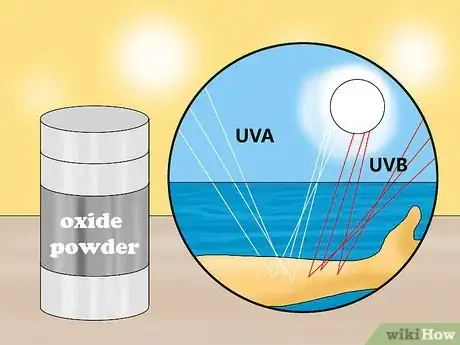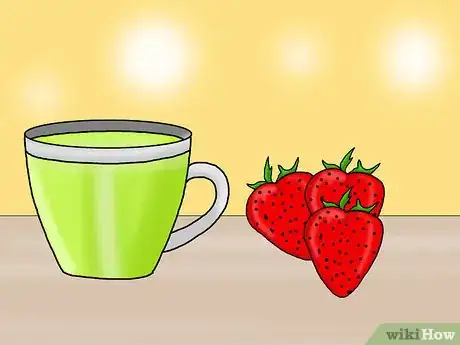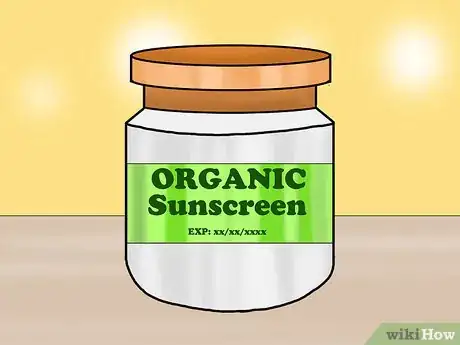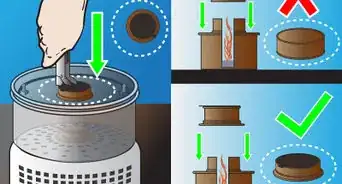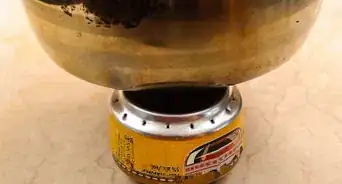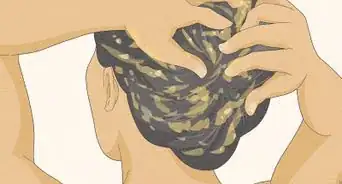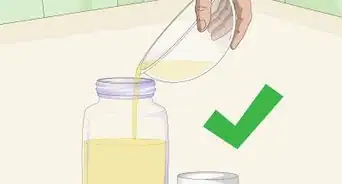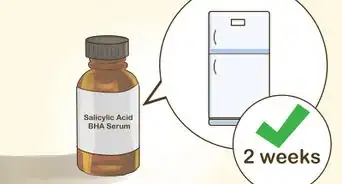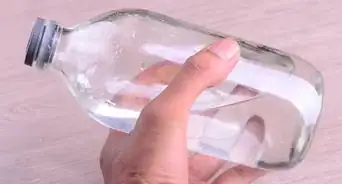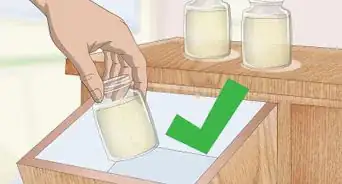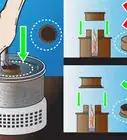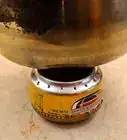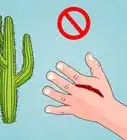This article was co-authored by wikiHow Staff. Our trained team of editors and researchers validate articles for accuracy and comprehensiveness. wikiHow's Content Management Team carefully monitors the work from our editorial staff to ensure that each article is backed by trusted research and meets our high quality standards.
There are 8 references cited in this article, which can be found at the bottom of the page.
This article has been viewed 263,814 times.
Learn more...
Many commercial sunscreen products contain chemicals that can be harmful to one’s health. As a result, some people have begun making their own sunscreens using natural oils, waxes, and oxide powders. Note that although it is possible to make a viable sunscreen with these ingredients, health professionals advise against it as there is no way to confirm the level of UV protection that homemade sunscreens provide.
Steps
Making Sunscreen with Oil, Beeswax, and Oxide
-
1Gather your ingredients. This recipe makes 11 ounces of sunscreen with an estimated SPF of 10 to 15:
- 1 cup Olive oil or other natural oil (grocery store)
- 1 oz (28 g) Pure beeswax (health food store or online)
- 1 to 2 tbsp USP grade zinc oxide or titanium dioxide powder (health food store, pharmacy or online)
- Essential oil (optional)
-
2Gather your tools. In addition to your ingredients, you’ll need the following tools for making the sunscreen. These tools should only be used for making sunscreen, as residual oxide powder could leech into your food and make you ill.
- Saucepan
- Heat-resistant glass jar (optional, if using double-boiler method)
- Spoon for stirring
- Gloves and face mask
- Stove
- Storage container with lid (glass jar, ceramic pot, or plastic bottle will do)
Advertisement -
3Pour the base oil into a saucepan and heat it. If you’re using a gas stove, use a low flame. If you’re using an electric stove, set your element to a medium heat.
- To ensure the integrity of the ingredients, you might try using a double-boiler method to melt them instead of placing them directly in the saucepan. This will also save you from having to only use your saucepan for making sunscreen.
- To use the double-boiler method, heat an inch or two of water in a saucepan until it’s simmering, then mix the ingredients (NOT including the oxide powder) in a heat-resistant glass jar and place the jar upright into the water, allowing it to sit there until all of the ingredients are melted together.
-
4Add 1 ounce of beeswax to the saucepan. If it’s not already in pearls or broken into pieces, you’ll need to grate or chop the beeswax into small pieces before adding it to the oil. This will help it melt faster.
- The beeswax makes the resulting product viscous, like a skin cream. It’s what holds the oxide in suspension so that it doesn’t all sink down to the bottom of the container.
- For a thicker, heavier sunscreen, add more beeswax. For one that is lighter and smooths on more easily, add a little less beeswax.[1]
-
5Stir constantly until the beeswax is completely melted in the hot oil. You want the ingredients to be completely melted together before you add the oxide powder.
-
6Add your essential oil (optional). If you want to add a fragrance to your sunscreen via an essential oil, now is the time to do it. Lavender oil is a popular choice, and has a natural SPF of up to 6.[2]
- Just use a couple of drops to ensure that it’s not an overly strong or irritating smell, especially if you intend to use it on your face.
-
7Put on your protective gear. Wear gloves and a face mask to protect you from coming in direct contact with the oxide powder. In particular, you want to protect yourself from inhaling it, which can be dangerous to your health.
- As an extra precaution you can also wear safety goggles, which will protect your eyes in case anything splashes up when you add the powder to the hot oil solution.
- As you’ll be dealing with hot oil, make sure that the gloves you wear are heat-resistant and won’t melt if any oil splashes up on to them. Heat-resistant rubber gloves will work well. Just make sure they fit you well so that you can still use your hands without feeling clumsy.
-
8Add 1 to 2 tbsp of oxide powder to the melted mixture. Add just a little bit at a time while constantly stirring to ensure that the mixture is well blended. The oxide powder must be evenly distributed throughout the mixture to make an effective sunscreen.
- You can use either zinc oxide or titanium dioxide, although zinc oxide seems to be more common amongst DIY sunscreen makers.
- Make sure the powder is USP grade, which means that it is suitable for food, drug, or medicinal use.
-
9Remove from heat and pour into storage container. Once everything is mixed together, remove the mixture from the stove and pour it into its storage container. Small mason jars with lids are highly recommended.
- Depending on the thickness of your mixture, you might be able to get away with a squeeze bottle. A wide-mouthed jar will make it easier for you to stir the solution while it cools though, and less of the solution will be likely to go to waste.
- If you’re pouring the mixture into a container with a narrow neck, use a pastry bag to squeeze the sunscreen through. It will likely be too thick for a funnel. Just make sure that the sunscreen isn’t still very hot while you do this lest you burn yourself.
-
10Stir while cooling to ensure even distribution. As the mixture cools, stir it every 5 to 10 minutes to ensure that the oxide powder remains evenly distributed throughout the mixture.[3]
-
11Allow to cool to room temperature before use. Once the sunscreen is room temperature, you can put it on your skin. Note that the sunscreen should be opaque. If it looks translucent, the oxide has likely sunk to the bottom of the container.
- The oxide can settle when the sunscreen is cooling. It can also sink to the bottom of the container if it is out in the heat for too long. It’s important to stir it or shake it up before use in these situations, so that you get the full protective benefits of the oxide.
-
12Label, date and store in a cool place. It’s best if you can use this, or any other homemade sunscreens, within six months of making it.[4] Make sure you keep it in a cool, dry place.
- If the sunscreen gets too hot or too cold, the ingredients might shift. If the oxide powder isn’t evenly distributed throughout the sunscreen, it will not be effective.
- If the sunscreen melts or hardens, you will need to stir the sunscreen to evenly distribute the oxide powder once it’s back at room temperature and a regular thickness.
Creating Your Own Sunscreen Recipe
-
1Explore other DIY sunscreen recipes. Explore what recipes other DIY sunscreen makers are using. This will give you a sense of what ingredients are popular, and what ingredients you may want to use.
-
2Try this DIY sunscreen recipe. One DIY sunscreen maker suggests the following recipe, which combines several different oils. Simply melt all of the ingredients EXCEPT the zinc oxide together, then add the zinc oxide, cool, and you’re done.[5]
- 1/2 cup Almond or olive oil
- 1/4 cup Coconut oil
- 1 tsp Red raspberry oil (optional)
- 1 tsp Carrot seed oil (optional)
- 1 tsp Vitamin E oil (optional)
- A few drops of essential oils of your choosing (optional)
- 2 tbsp Shea butter
- 1/4 cup Beeswax
- 2 tbsp zinc oxide
-
3Change DIY sunscreen recipes to suit your own tastes. Once you’ve read or even tried other DIY sunscreen recipes, such as the ones in this article, you can add your own ingredients to the sunscreen to tailor it to your tastes.
- As an example, you might add lavender oil and cut the beeswax content of the DIY recipes in this article for a lighter, lavender-scented sunscreen that easily smooths over your skin.
-
4Know the different base oils. The base oil is the oil that you will use the most of in your homemade sunscreen recipe. Popular base oils include olive oil (SPF 7-8), coconut oil (SPF 7), castor oil (SPF 6), and almond oil (SPF 5).[6]
-
5
-
6Try red raspberry seed oil. Red raspberry seed oil is a popular choice amongst DIY sunscreen makers, who claim that it has an SPF of 25 to 50.[9] You can add a small amount of it to your sunscreen to boost its SPF level.
-
7Try carrot seed oil. With an SPF of 35 to 40, carrot seed oil is a DIYer favorite.[10] Try adding a small amount of carrot seed oil to your homemade sunscreen to enhance its SPF level.
-
8Experiment with shea butter. Shea butter is believed to have a natural SPF of 4 to 6. Adding it to your sunscreen will help thicken it. Shea butter is also a great moisturizer, and will leave your skin feeling soft and smooth.
-
9Always add an oxide to your sunscreen. The most important ingredient in homemade sunscreen is oxide, which comes in the form of either zinc oxide or titanium dioxide. Both of these offer protection against UVA and UVB rays, and are an absolute must.
Learning About Sun Protection
-
1Know the risks involved in making your own sunscreen. The efficacy of your homemade sunscreen is not only based on your ingredients, but on the way in which you’ve made the sunscreen. This is the primary concern expressed by doctors when discussing DIY sunscreen.
- Doctors worry that even if the ingredients are effective, the way in which they are mixed might undermine them. For instance, if your oxide powder isn’t properly blended with the rest of the ingredients, it might only protect your skin in patches, or worse, not at all.[13]
- Doctors also warn that since DIY sunscreen makers don’t usually have labs or testing environments for their sunscreen, there is no scientific way to properly measure the level of UV protection their mixtures provide.[14]
-
2Learn the difference between SPF and broad-spectrum protection. SPF only measures the ability to block UVB rays, which are the rays that burn you. It does not protect against UVA rays, which are what age you. Both types of rays can cause skin cancer.[15]
- To be properly protected, you must have a sunscreen that protects against booth UVA and UVB rays.
- This is why it’s so important to have a good amount of oxide powder in your sunscreen. Zinc oxide in particular is good at blocking UVA and UVB rays.[16]
-
3Eat UV-fighting foods. If you’re interested in boosting your skin’s natural protective barrier against the sun, there are foods that you can eat to help. Note that consuming these things is not enough to protect you from the sun. You must wear sunscreen.
- Cocoa, green and black tea, micro-algae (chlorella and spirulina), and carotenoids and antioxidants found in fruits and veggies are all great for boosting your skin’s natural ability to fight the sun’s harmful rays.
-
4Seek alternatives to homemade sunscreen. As reports of dangerous chemicals in store-bought sunscreens have scared people off buying them, natural options have become more popular and affordable.
- It’s now relatively easy to find sunscreen options that are organic, chemical free, and just as safe as your homemade concoction, with the added benefit of being lab-tested for UV protection.
Community Q&A
-
QuestionWhat amount of protection does this mix offer compared to the sunscreens bought from a store?
 Community AnswerIt depends entirely on how you make it. More zinc/titanium means more protection but also more visible residue on your skin; less means less protection but less visible residue.
Community AnswerIt depends entirely on how you make it. More zinc/titanium means more protection but also more visible residue on your skin; less means less protection but less visible residue. -
QuestionDoes this sunscreen mixture absorb well into the skin or does the skin stay white with this product?
 Timariya KilpatrickCommunity AnswerIt absorbs if you rub it in well. If not, it will stay white on your skin.
Timariya KilpatrickCommunity AnswerIt absorbs if you rub it in well. If not, it will stay white on your skin. -
QuestionHow can I make sunscreen from kitchen products?
 Community AnswerThe instructions above are going to be as close as you can get. The olive oil is likely already in your kitchen; beeswax isn't hard to get; but you may need to order the powder.
Community AnswerThe instructions above are going to be as close as you can get. The olive oil is likely already in your kitchen; beeswax isn't hard to get; but you may need to order the powder.
Warnings
- To avoid any health risks that can arise from inhaling oxide fumes or consuming oxide, reserve any of the tools you use to make sunscreen only for that purpose. Do not reuse them for food-making purposes once they’ve been used to make sunscreen.⧼thumbs_response⧽
- Keep the sunscreen and any leftover oxide powders out of reach of children and pets. It should not be ingested.⧼thumbs_response⧽
- Keep the sunscreen out of direct heat, otherwise it may melt and the powder will sink down to the bottom of the container. If this happens, give the solution a stir and allow it to cool. You may need to put it in the fridge for a short time, taking it out to stir every once in a while to ensure that the zinc oxide is evenly distributed.⧼thumbs_response⧽
- Inhaling zinc oxide fumes can be dangerous for your health. For this reason, is important to wear a face mask while adding the powder to your oil solution.⧼thumbs_response⧽
- If your sunscreen is not opaque, the oxide has sunk to the bottom and you will not be protected from the sun’s rays. If it is translucent, you’re not protected.⧼thumbs_response⧽
- Do not use citrus oils in your homemade sunscreen, as they are phototoxic and can cause your skin to burn badly.[20]⧼thumbs_response⧽
- Many health professionals warn against making your own sunscreen, as there is no way to test its efficacy before it is used. For example, the way you combine the ingredients could render them ineffective, and you won't know that until you wind up with a sunburn.[21]⧼thumbs_response⧽
Things You'll Need
- Saucepan
- Heat-resistant glass jar for double boiling (optional)
- Spoon for stirring
- Gloves
- Face mask (to protect from inhaling oxide powder)
- Protective goggles (optional)
- Stove, even a camp stove will work fine
- Storage container
- Olive oil or another natural oil
- Pure beeswax
- Pure (USP grade) zinc oxide or titanium dioxide powder
- Essential oils (optional)
- Shea butter (optional)
References
- ↑ https://wellnessmama.com/beauty/homemade-sunscreen/
- ↑ http://www.ncbi.nlm.nih.gov/pubmed/4096528
- ↑ https://wellnessmama.com/beauty/homemade-sunscreen/
- ↑ https://wellnessmama.com/beauty/homemade-sunscreen/
- ↑ https://wellnessmama.com/beauty/homemade-sunscreen/
- ↑ http://www.ncbi.nlm.nih.gov/pmc/articles/PMC3140123/
- ↑ http://www.ncbi.nlm.nih.gov/pmc/articles/PMC3140123/
- ↑ http://www.ncbi.nlm.nih.gov/pubmed/4096528
- ↑ https://wellnessmama.com/beauty/homemade-sunscreen/
- ↑ https://wellnessmama.com/beauty/homemade-sunscreen/
- ↑ http://www.skincancer.org/skin-cancer-information/ask-the-experts/how-much-sunscreen-should-i-be-using-on-my-face-and-body
- ↑ http://www.skincancer.org/skin-cancer-information/ask-the-experts/how-much-sunscreen-should-i-be-using-on-my-face-and-body
- ↑ http://www.dailymail.co.uk/health/article-2702190/Alert-DIY-organic-sunscreens-oils-Doctors-warn-against-following-nonsense-internet-advice-oils-offer-protection-rating-50.html
- ↑ http://www.dailymail.co.uk/health/article-2702190/Alert-DIY-organic-sunscreens-oils-Doctors-warn-against-following-nonsense-internet-advice-oils-offer-protection-rating-50.html
- ↑ https://www.sciencebasedmedicine.org/the-great-sunscreen-cover-up/
- ↑ http://www.skincancer.org/skin-cancer-information/ask-the-experts/how-much-sunscreen-should-i-be-using-on-my-face-and-body
- ↑ https://wellnessmama.com/beauty/homemade-sunscreen/
- ↑ http://www.skincancer.org/skin-cancer-information/ask-the-experts/how-much-sunscreen-should-i-be-using-on-my-face-and-body
- ↑ http://www.ewg.org/2015sunscreen/report/nanoparticles-in-sunscreen/
- ↑ http://www.ncbi.nlm.nih.gov/pubmed/4096528
- ↑ http://www.dailymail.co.uk/health/article-2702190/Alert-DIY-organic-sunscreens-oils-Doctors-warn-against-following-nonsense-internet-advice-oils-offer-protection-rating-50.html
- Videos provided by ModaMob
About This Article
To make sunscreen, start by pouring the olive oil into a saucepan and heating it over medium heat. Next, add grated beeswax to the saucepan and stir the mixture constantly until the wax is completely melted. Then, put on protective gloves and a face mask before stirring in a USP grade oxide powder like zinc oxide or titanium dioxide. Once the ingredients are combined, remove the saucepan from the heat and pour the sunscreen into a storage container to cool. For tips on storing your homemade sunscreen, read on!

